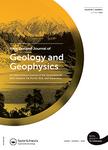版权所有:内蒙古大学图书馆 技术提供:维普资讯• 智图
内蒙古自治区呼和浩特市赛罕区大学西街235号 邮编: 010021

作者机构:Univ Otago Dept Geol Dunedin New Zealand
出 版 物:《NEW ZEALAND JOURNAL OF GEOLOGY AND GEOPHYSICS》 (新西兰地质学与地球物理学杂志)
年 卷 期:2016年第59卷第2期
页 面:352-365页
核心收录:
学科分类:0709[理学-地质学] 081803[工学-地质工程] 07[理学] 08[工学] 0708[理学-地球物理学] 0818[工学-地质资源与地质工程]
基 金:Royal Society of New Zealand Marsden Grant University of Otago
主 题:Freshwater and brackish fauna lignite-bearing cyclic sequence New Zealand Oligocene estuary paleoecology paleogeography Pomahaka Formation
摘 要:Pomahaka Formation, a late Oligocene succession of interbedded mudstone, lignite, shell beds and thin sands, was studied in small exposures along the Pomahaka River near Tapanui, Otago and in four adjacent sections in Waikoikoi Creek where about 17 x 0.25-4.0mthick facies cycles were exposed. At the base of an ideal cycle, thinly laminated sandy mudstone overlying lignite of the previous cycle records transgressive flooding of forest swamp by fresh or estuarine waters. Laminated shelly mudstone containing venerid bivalves (Hinemoana acuminata) forming the middle of several cycles represents maximum marine flooding. Above this, trough cross-stratified beds and sand with mud flaser laminae record progradation of distributary bars and/or intertidal sands. Finally, deposition of root-burrowed mudstone and lignite mark the re-establishment of swamp forest. Predominantly muddy sediment texture, the association of lignite, distinctive fresh- and brackish-water faunas and thin depositional cycles indicate a microtidal estuarine paleo-environment in southern Zealandia during late Oligocene time.